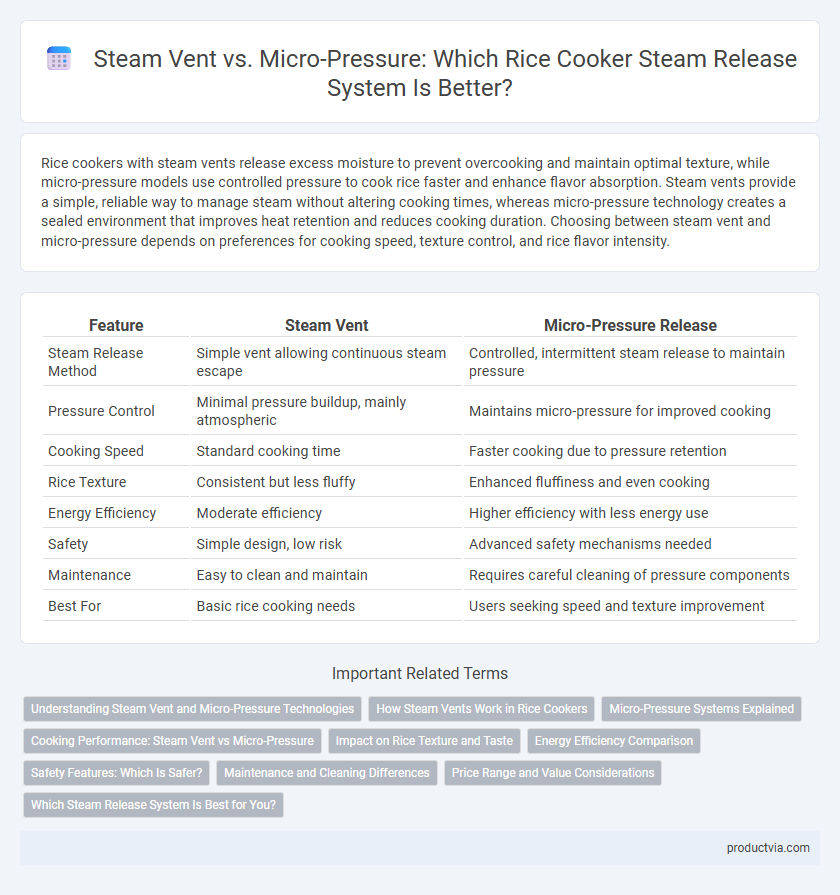Rice cookers with steam vents release excess moisture to prevent overcooking and maintain optimal texture, while micro-pressure models use controlled pressure to cook rice faster and enhance flavor absorption. Steam vents provide a simple, reliable way to manage steam without altering cooking times, whereas micro-pressure technology creates a sealed environment that improves heat retention and reduces cooking duration. Choosing between steam vent and micro-pressure depends on preferences for cooking speed, texture control, and rice flavor intensity.
Table of Comparison
| Feature | Steam Vent | Micro-Pressure Release |
|---|---|---|
| Steam Release Method | Simple vent allowing continuous steam escape | Controlled, intermittent steam release to maintain pressure |
| Pressure Control | Minimal pressure buildup, mainly atmospheric | Maintains micro-pressure for improved cooking |
| Cooking Speed | Standard cooking time | Faster cooking due to pressure retention |
| Rice Texture | Consistent but less fluffy | Enhanced fluffiness and even cooking |
| Energy Efficiency | Moderate efficiency | Higher efficiency with less energy use |
| Safety | Simple design, low risk | Advanced safety mechanisms needed |
| Maintenance | Easy to clean and maintain | Requires careful cleaning of pressure components |
| Best For | Basic rice cooking needs | Users seeking speed and texture improvement |
Understanding Steam Vent and Micro-Pressure Technologies
Steam vent technology in rice cookers allows excess steam to escape through a designated outlet, preventing pressure buildup and ensuring safe cooking. Micro-pressure technology maintains a controlled pressure environment inside the cooker, enhancing heat distribution and reducing cooking time while preserving rice texture. Understanding these mechanisms helps users choose a rice cooker that balances safety, efficiency, and quality of cooked rice.
How Steam Vents Work in Rice Cookers
Steam vents in rice cookers regulate internal pressure by allowing excess steam to escape during cooking, preventing buildup that could affect rice texture. These vents maintain optimal moisture levels, ensuring rice cooks evenly without becoming soggy or dry. Compared to micro-pressure release systems, traditional steam vents rely on simple pressure balance to enhance cooking safety and consistency.
Micro-Pressure Systems Explained
Micro-pressure systems in rice cookers regulate steam release by maintaining slightly elevated internal pressure, which enhances heat retention and promotes faster, more even cooking compared to traditional steam vents. This controlled pressure environment improves the texture and flavor of rice by ensuring optimal moisture absorption and preventing overcooking. Unlike standard steam vents that release excess steam freely, micro-pressure systems balance pressure buildup and release, resulting in consistent, high-quality rice preparation.
Cooking Performance: Steam Vent vs Micro-Pressure
Steam vent release in rice cookers allows excess steam to escape continuously, maintaining a consistent internal pressure that prevents overcooking and ensures evenly cooked rice. Micro-pressure technology creates a slightly elevated pressure environment, enhancing heat penetration and moisture retention, which results in fluffier, more tender rice with improved texture. Cooking performance with micro-pressure is superior for types requiring precise moisture control, while steam vents offer reliable results for everyday rice varieties.
Impact on Rice Texture and Taste
Steam vents in rice cookers allow gradual release of moisture, producing fluffier rice with separated grains and a light texture. Micro-pressure systems trap steam at slightly higher pressure, enhancing starch gelatinization for a chewier, denser texture and richer flavor. Choosing between steam vent and micro-pressure directly influences moisture retention and rice taste, tailor-made for preference in texture firmness and aroma intensity.
Energy Efficiency Comparison
Steam vent rice cookers release excess steam continuously during cooking, which can result in moderate energy consumption due to heat loss. Micro-pressure rice cookers retain steam within a sealed environment, increasing internal pressure and temperature, thereby reducing cooking time and enhancing energy efficiency by conserving heat. This pressurized steam release mechanism typically leads to lower electricity usage compared to traditional steam vent models.
Safety Features: Which Is Safer?
Rice cookers with steam vents typically offer a straightforward release of steam, reducing the risk of pressure buildup and enhancing safety through controlled evaporation. Micro-pressure technology uses precise pressure regulation to cook rice faster while minimizing steam emissions, incorporating advanced safety valves to prevent accidents under high pressure. Comparing both, micro-pressure systems often provide enhanced safety by integrating multiple fail-safe mechanisms, although traditional steam vent models are simpler and less prone to mechanical failure.
Maintenance and Cleaning Differences
Rice cookers with steam vents require regular cleaning to prevent clogging from starch buildup, often involving the removal of detachable vent caps for thorough washing. Micro-pressure steam release systems have sealed mechanisms that reduce residue accumulation, resulting in less frequent and easier maintenance. Both types benefit from routine inspections, but micro-pressure models typically simplify cleaning due to fewer exposed components.
Price Range and Value Considerations
Steam vent rice cookers typically fall into a lower price range, making them an affordable option for basic cooking needs with straightforward steam release technology. Micro-pressure models command a higher price but offer enhanced cooking precision and faster rice preparation, providing greater value for users seeking advanced features. Evaluating the balance between initial cost and cooking performance helps determine the best fit for individual budgets and culinary requirements.
Which Steam Release System Is Best for You?
A rice cooker's steam vent system determines how moisture escapes during cooking, with traditional steam vents offering consistent pressure release for fluffy rice and micro-pressure technology enhancing texture by maintaining higher internal pressure. Micro-pressure steam release systems typically provide faster cooking times and better retention of nutrients and flavor, ideal for users seeking efficient, gourmet-quality rice. Choosing between these depends on your preference for simplicity and reliability or advanced cooking performance with precise steam control.
Steam vent vs micro-pressure for rice cooker steam release Infographic

 productvia.com
productvia.com